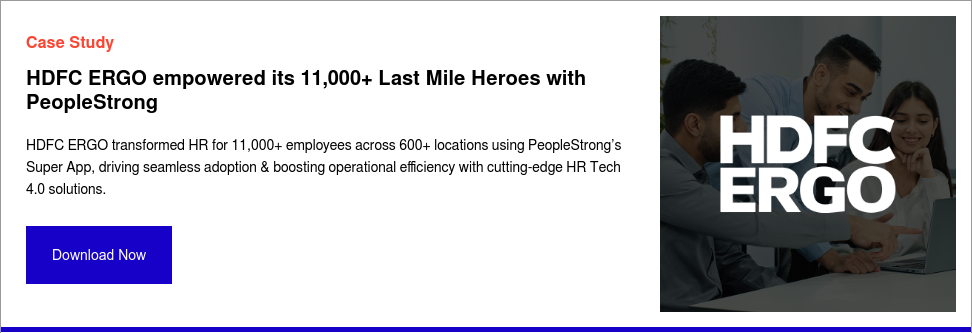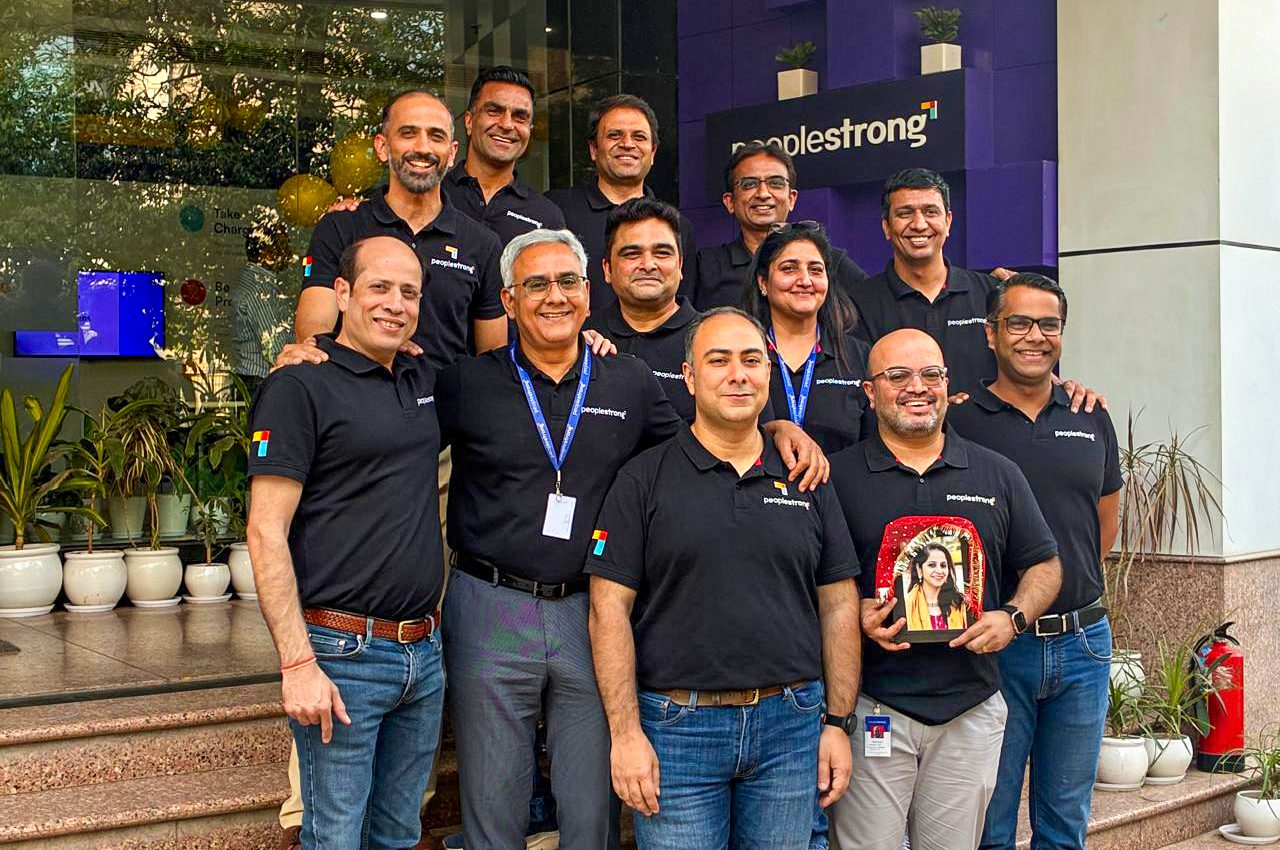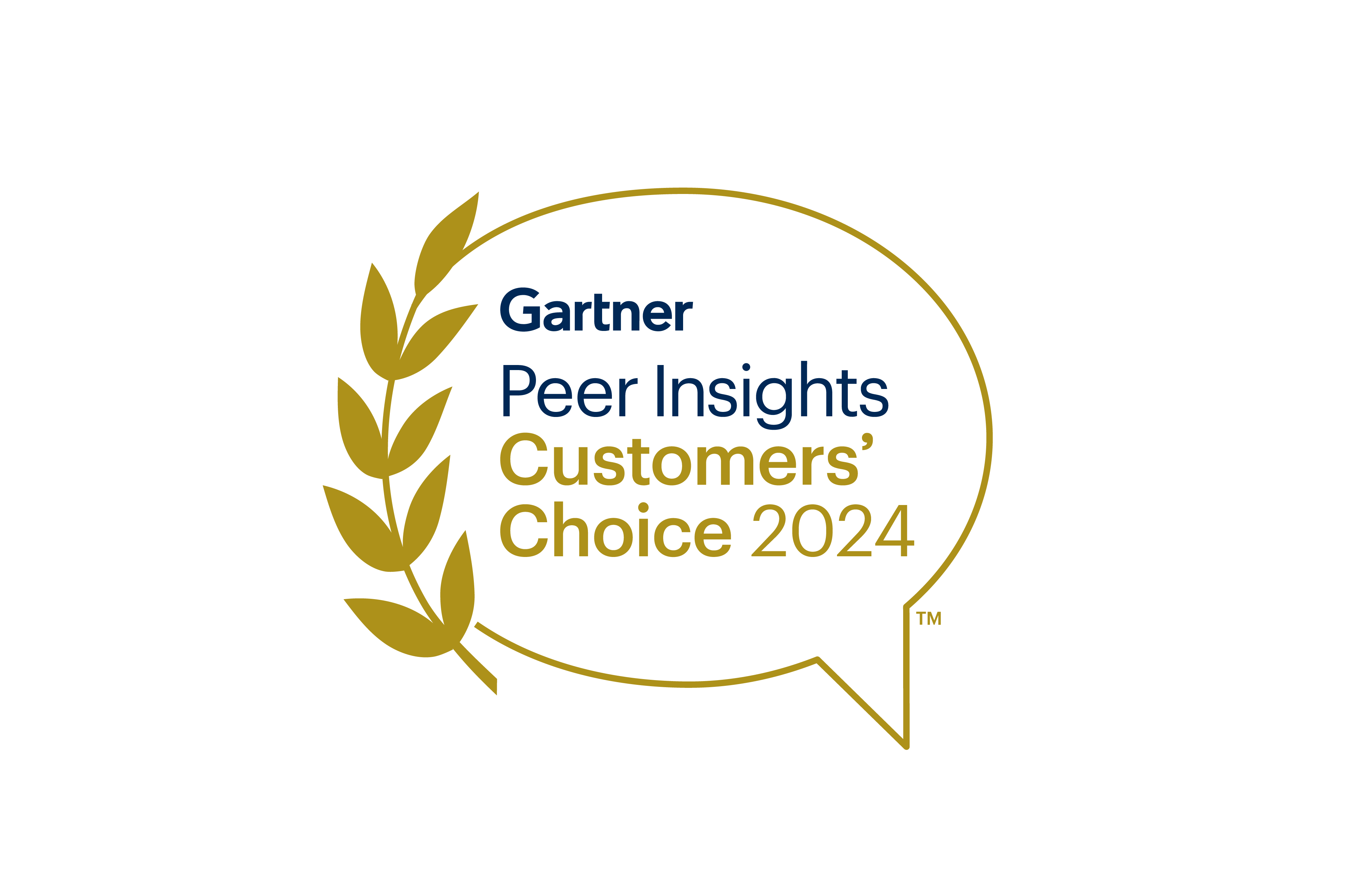You’re not alone if you’ve ever managed employee data in an Excel sheet that suddenly vanished. As your team grows, so does the chaos—attendance tracking, payroll, compliance, performance reviews—everything is scattered across tools that don’t sync with each other.
That’s when you know it’s time for smarter systems.
The best HRMS software in India goes beyond organising your HR tasks; it saves time, reduces errors, and lets you focus on people, not paperwork. In fact, around 80% of organisations have some HRMS software in place to help them out.
Whether you’re running a lean startup or a fast-scaling SME, picking the best HRMS software is no longer optional—it’s survival. We’ve shortlisted 11 solid options that help simplify operations without making you feel like you need a tech degree to use them.
Top Features to Look Out for While Choosing the Best HRMS Software
Choosing the best HRMS software in India isn’t about picking the one with the longest list of features—it’s about what actually works for your team. Here are the key features to look for in an HRMS tool:
- Payroll Management: Automatically handles salaries, tax deductions (TDS), bonuses, and compliance filings. It should also generate payslips and integrate with your accounting software so you don’t have to do manual entries.
- Attendance & Leave Tracking: Track check-ins, check-outs, and total working hours through biometric devices, mobile apps, or web logins. Leave requests can be managed digitally, with auto-updates to balances and manager approvals.
- Employee Self-Service (ESS): Gives employees direct access to their data—like payslips, leave balance, or personal information—without pinging HR for every little thing. Saves time for both sides.
- Performance Management: Set OKRs/KPIs, collect manager and peer feedback, and conduct reviews in a structured, trackable format. Some tools even help with 360-degree feedback and improvement tracking.
- Recruitment & Onboarding: According to a study, effective onboarding can increase retention rates by 82%. So, streamlining this hiring process, from posting job openings to screening applicants to sending offer letters, can be pretty helpful. After hiring, it can trigger automated onboarding steps like document collection and team introductions.
- Compliance Management: Keeps your company on the right side of labour laws. This includes PF, ESI, gratuity, bonus calculations, and automated reports for audits or government filings.
- Analytics & Reporting: Generate real-time reports on headcount, attrition, payroll costs, or any other HR metric you need. Helps with smarter decision-making instead of relying on guesswork.
- Custom Workflows: Every company has its quirks. Custom workflows let you set your approval chains, notifications, and task assignments, so the system works the way you do.
13 Best HRMS Software in India
With dozens of options in the market, shortlisting the best HRMS software in India can get overwhelming. So, we’ve done the heavy lifting. Here’s a handpicked list of 13 HR tools, each offering something unique to help you simplify HR operations and take people management up a notch:
1. PeopleStrong
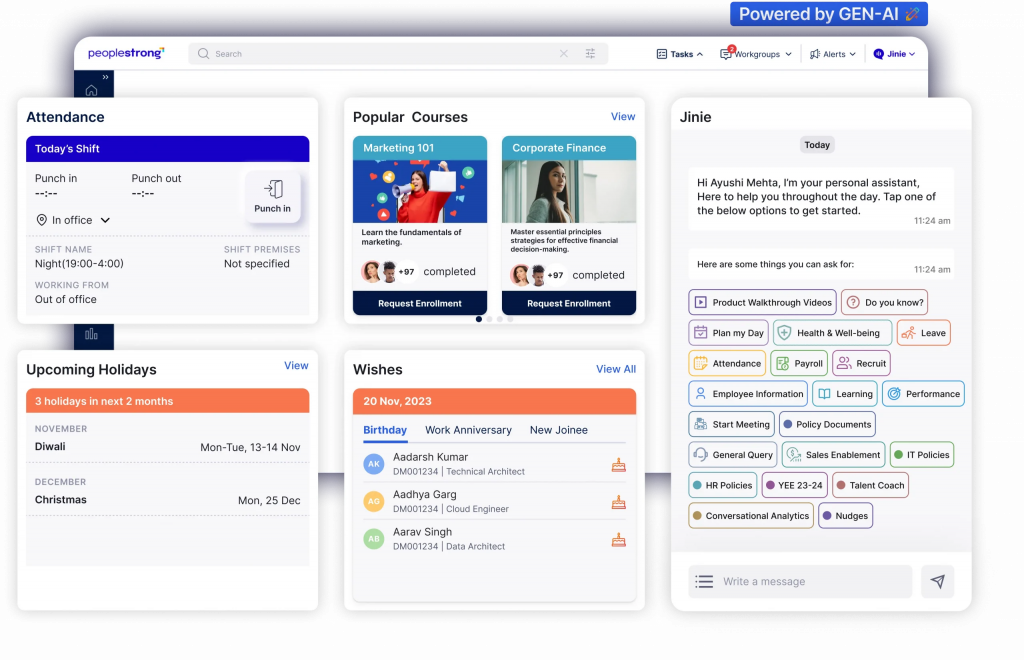
If there’s one name that’s rewriting how enterprises in India manage their people, it’s PeopleStrong. Built for scale and speed, this AI-driven HRMS does more than automate—it anticipates, engages, and elevates every stage of the employee lifecycle. From hiring to offboarding, everything sits under one integrated roof, giving you full control without the bloat.
At the heart of PeopleStrong is Jinie, an AI-powered talent coach that does way more than answer FAQs. It nudges employees to hit their OKRs, recommends learning paths based on career goals, connects with your Outlook or Gmail, and runs 24/7 as a helpdesk, wellness advisor, and engagement companion.
The platform doesn’t just offer dashboards—it delivers actionable insights. Whether it’s screening CVs faster, triggering pulse surveys, or flagging low engagement signals, PeopleStrong turns data into clear, everyday decisions.
Best features
- Automate hiring, onboarding, payroll, and performance reviews from a single platform
- Use Jinie to boost productivity with contextual nudges, learning paths, and round-the-clock HR support
- Launch AI-led daily mood checks, feedback loops, and employee engagement campaigns
- Connect seamlessly to 100+ external tools and run it all from mobile
Ideal for: Large enterprises looking for end-to-end automation with AI capabilities
2. Workday

Workday stands out for combining HR and finance in a single, unified platform—something most HRMS tools don’t even attempt. Its strength lies in deep analytics and real-time data insights that help decision-makers think beyond just payroll or onboarding.
The platform is packed with 350+ AI-powered enhancements (and counting), including Workday Illuminate, their agentic AI engine designed to optimise both human and digital workforces.
If you want to make talent decisions backed by data and automate tasks at scale, Workday brings serious enterprise power to the table—minus the clunky interfaces you’d expect from a legacy system.
Best features
- Automate payroll, onboarding, and financial workflows in one place
- Track real-time workforce data to make faster, smarter decisions
- Use Workday Illuminate™ to assign, delegate, and optimise tasks using AI
- Scale your HR processes without breaking your existing structure
Ideal for: Enterprises seeking a single platform for both people and finance management with deep AI integration
3. greytHR

If you’re still juggling spreadsheets for payroll or tracking attendance manually, greytHR is probably the fastest way out of that mess. It’s built for small to mid-sized businesses that want plug-and-play simplicity without sacrificing control or compliance.
It’s built mobile-first—your team can access payslips, claim expenses, or apply for leave straight from their phone. It handles core HR, payroll, attendance, and even letters and exit workflows, all while staying compliant with India’s tricky regulations.
Their in-house implementation support ensures smooth onboarding, even if you’re not tech-savvy.
Best features
- Automate payroll, attendance, onboarding, and offboarding with zero manual effort
- Give employees mobile self-service access for payslips, leave, and claims
- Generate 150+ ready-to-use reports covering payroll, compliance, MIS, and more
- Eliminate integration headaches with guided implementation from the greytHR team
Ideal for: SMBs that want a cost-effective HRMS with strong local compliance and mobile accessibility
4. ZingHR
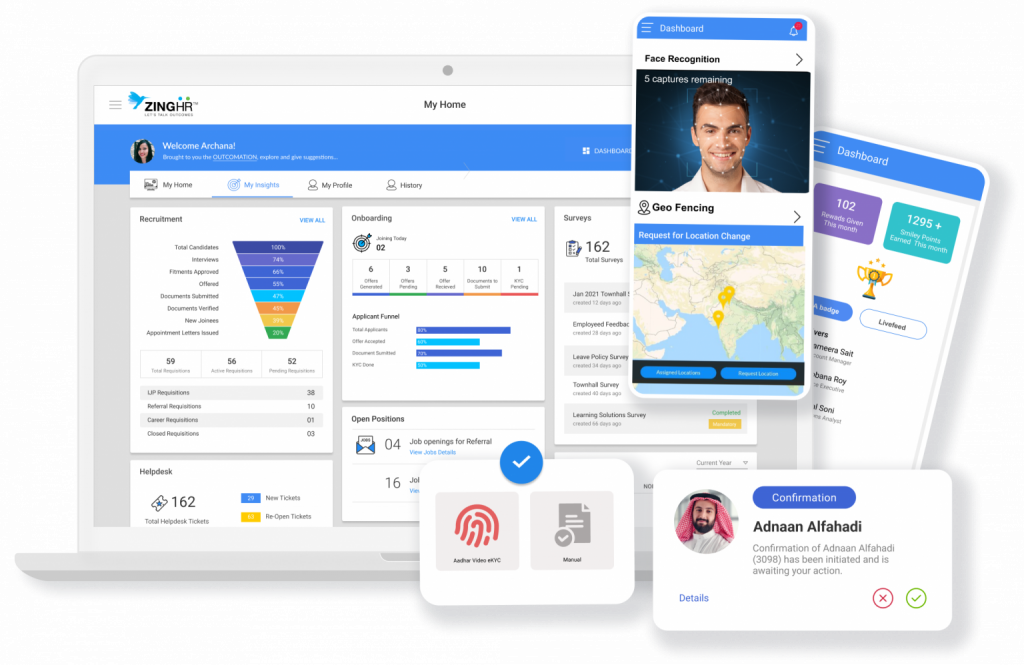
ZingHR takes a vertical-specific approach to HRMS, focusing heavily on outcome-based delivery. What sets it apart is its Outcomation framework, designed to shift your HR function from being a cost center to a business outcome driver.
Built for end-to-end lifecycle management—from hire to rehire—the platform is equipped with AI-supported modules that adapt to industry-specific workflows.
Their AI Moonshot Challenge isn’t just branding—it’s a real push toward automating deeper HR decisions. ZingHR is big on custom-fit implementations, offering tailored modules for BFSI, manufacturing, retail, pharma, and other high-volume sectors.
Best features
- Customise HR workflows for your industry using ZingHR’s vertical-first approach
- Automate end-to-end processes, including hiring, onboarding, payroll, and offboarding
- Track employee productivity and engagement using AI-powered insights
- Use electronic integrations for compliance, reporting, and L&D at scale
Ideal for: Enterprises seeking an HRMS with vertical-specific capabilities and measurable business outcomes
5. Zoho People

Zoho People offers a no-fuss, modular HRMS that’s ideal for businesses scaling their workforce without wanting to overcomplicate things. It’s entirely cloud-based and mobile-friendly, so your HR team and employees can handle everything—from onboarding and performance tracking to leave management—on the move.
Its real strength lies in the balance between customisation and usability. For teams working across remote setups or hybrid structures, Zoho People’s app and chatbot “Zia” add that extra convenience layer, keeping people connected without needing desktop access.
Best features
- Set up automated onboarding, leave policies, and performance reviews with minimal effort
- Use Zia, the built-in HR chatbot, to assist employees with routine queries
- Analyse workforce trends using advanced HR analytics and custom dashboards
- Integrate with popular tools like Google Workspace, Microsoft 365, and Zoho Payroll
Ideal for: Mid-sized businesses looking for a flexible, cloud-based HRMS with strong integration support and user-friendliness
6. ADP Workforce Now

ADP Workforce Now is a powerful, enterprise-grade HRMS built for businesses that want full control over payroll, HR, benefits, and compliance—all in one place.
What separates ADP from many others is its deep industry benchmarking and analytics capability, drawing from a database of over 42 million employees. You’re not just tracking numbers—you’re comparing them against real-time market data to guide decisions.
Best features
- Run payroll, benefits, HR tasks, and compliance from a single dashboard
- Tap into real-time market benchmarks to compare compensation and attrition
- Automate onboarding, time tracking, and employee self-service actions
- Get live support, client success managers, and rapid implementation assistance
Ideal for: Mid-to-large enterprises looking for a scalable, data-rich HRMS with strong implementation and support structure
7. Freshservice (by Freshworks)

Freshservice isn’t a full-blown HRMS in the traditional sense—it’s more of a service management tool adapted for HR teams that prioritise process efficiency and internal support.
If your HR department functions like an internal helpdesk (handling everything from policy queries to onboarding workflows), Freshservice gives you the tools to automate and manage that at scale.
Best features
- Create and manage an internal HR service desk with ticketing and case resolution
- Automate onboarding steps, multi-level approvals, and recurring HR workflows
- Use AI chatbots to handle policy-related questions and reduce repetitive queries
- Track performance metrics and employee satisfaction with real-time dashboards
Ideal for: HR teams focused on service delivery, support ticketing, and workflow automation within large enterprises
8. HROne

HROne positions itself as an all-in-one HRMS for companies that want to automate everything—without adding complexity. The platform offers 127+ HR workflows packed into a single system, and it manages to keep the experience clean and intuitive. You don’t need a separate onboarding session just to figure out how it works.
From managing payroll and attendance to running performance cycles and tracking company assets, HROne is structured to cover every phase of the employee lifecycle.
Best features
- Handle recruitment, attendance, payroll, and performance in a single, unified system
- Use InboxForHR™ for task management without switching between modules
- Automate everything from onboarding to exit processes with configurable workflows
- Access HR functions on the go via a highly rated mobile app
Ideal for: Growing businesses that want a full-featured, secure HRMS without the learning curve
9. FactoHR

FactoHR is a cloud-based, mobile-first HRMS that delivers a full suite of features wrapped in an easy-to-use interface. Designed to scale with businesses of all sizes, it covers everything from payroll and performance to employee onboarding and retirement benefits.
The system is built around flexibility, allowing HR teams to configure processes while maintaining control and compliance. One standout is its highly functional mobile app, which comes loaded with features like contactless attendance, AI-driven face recognition, geo-fencing, and a chatbot.
Best features
- Use contactless attendance, geo-fencing, and face recognition for modern workforce tracking
- Let employees access ESS, submit queries, or check policies via the mobile app and chatbot
- Digitally manage retirement benefits like PF, gratuity, and superannuation from a single system
Ideal for: Businesses looking for a mobile-first HRMS with advanced time tracking and end-to-end lifecycle management, including retirement benefits
10. Sage HR

Sage HR is a lightweight, modular HRMS tailored for small and medium businesses that want flexibility without clutter. It gives you control over HR operations while letting you pick and pay for only the modules you actually need.
From leave tracking and employee records to performance reviews and shift scheduling, you can scale the tool as your business grows.
Its clean UI and mobile-ready design make it easy for both HR managers and employees to handle tasks like time-off requests, appraisals, and goal-setting. The platform also supports 360° feedback, one-on-one scheduling, and custom surveys to keep a pulse on engagement—all without overwhelming you with features you’ll never use.
Best features
- Automate leave approvals, timesheets, and shift scheduling with minimal admin input
- Set and track goals, conduct appraisals, and collect feedback via a performance module
- Access core HR tasks and employee data from anywhere using the mobile app
- Build your own HR stack with optional add-ons for expenses, recruitment, and more
Ideal for: Small to mid-sized businesses looking for a modular, cost-effective HRMS that’s easy to roll out and expand over time
11. Zimyo
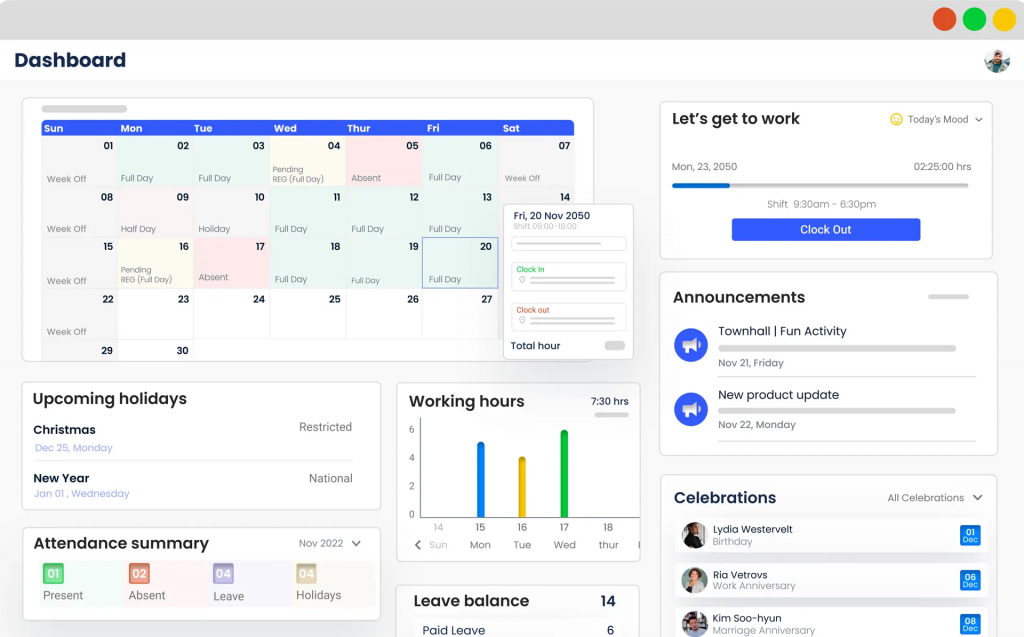
Zimyo is a full-stack HRMS built to give growing businesses a centralised, intuitive system for managing everything from recruitment and payroll to performance and compliance.
The platform is modular and scalable, making it easy to roll out core features like leave, attendance, and onboarding while expanding into advanced areas like OKRs, applicant tracking, and workforce analytics when you’re ready.
It leans heavily into automation and usability—you get AI-powered workflows, visual dashboards, and a strong mobile app for employees to manage tasks on the go.
Best features
- Automate the full employee lifecycle—from hiring and onboarding to exit and offboarding
- Access payroll automation, compliance, and incentive tracking in one unified platform
- Use AI tools for workflow management, performance reviews, and predictive workforce insights
- Provide employees with a seamless self-service portal and mobile app for all HR functions
Ideal for: Businesses seeking an all-in-one HRMS that balances depth, ease of use, and enterprise-level compliance
12. PeopleHum

PeopleHum is an AI-powered, all-in-one HRMS that covers the full hire-to-retire spectrum. It is designed for teams that want to streamline workflows, centralise data, and make more informed decisions.
The platform doesn’t just focus on operational efficiency; it leans heavily into employee experience, giving equal weight to engagement, performance, and feedback.
You get a single dashboard to manage everything—recruitment, onboarding, HRIS, payroll, performance tracking, and engagement campaigns. The built-in chatbot “Phia” helps employees interact with the system more naturally, and the analytics module offers real-time insights into key metrics.
Best features
- Automate the entire employee journey—from hiring to offboarding—in one interface
- Use AI tools and embedded analytics to track performance and workforce trends
- Boost engagement with built-in recognition tools, feedback loops, and surveys
- Provide mobile-first access and SSO support for distributed, hybrid teams
Ideal for: Modern businesses that want a unified, AI-enabled HRMS with a strong focus on employee engagement and automation
13. Keka

Keka is a full-suite HR and payroll platform built for organisations that want control, clarity, and automation in one place. What makes Keka different is how tightly it connects core HR, payroll, performance, and timesheet management—without overcomplicating the experience.
From hiring and onboarding to cascading OKRs, payroll processing, and project tracking, every module is integrated with analytics that help HR teams act faster. Employees can manage taxes, expenses, time-off, and even peer recognition via mobile or web.
Keka is also flexible enough to handle both blue-collar and white-collar teams across industries like retail, IT, pharma, and BFSI.
Best features
- Automate payroll in six simple steps with built-in tax compliance and expense tracking
- Create, assign, and align SMART goals and OKRs across departments
- Track time, attendance, and project utilisation with remote, biometric, or GPS-based inputs
- Provide employees with self-service tools for everything from appraisals to payslips
Ideal for: Mid-sized to large businesses looking for a unified HRMS that blends people operations, payroll, and performance into one streamlined system
How to Choose the Best HRMS Software (Guide)
Choosing the best HRMS software isn’t just about features—it’s about finding the right fit for your team, your workflows, and how you plan to grow. Here’s a simple 5-step guide to help you decide with clarity:
1. Identify your Biggest HR Pain Points
Start with what’s broken or inefficient—manual payroll? Scattered leave requests? Performance tracking chaos? Knowing your top 2–3 issues will help you cut through the noise and focus on tools that solve real problems.
2. Define your Must-Haves Vs Nice-To-Haves
Create a checklist. Do you need mobile access? Multi-location support? Payroll integration? Separate the features you need today from the ones you might need later.
3. Set Your Budget—But Think Long-Term
Don’t just look at license costs. Factor in onboarding, training, integrations, and hidden charges. A slightly more expensive tool with better scalability might save more in the long run.
4. Test the Software With Your Team
Always go for a free trial or demo. Involve actual users—HR team, managers, even a few employees. If they find it confusing or clunky, you’ll likely face adoption issues later.
5. Check Integration and Support Quality
The best HRMS software should connect smoothly with your existing tools—like payroll, accounting, or email. And when things break, responsive support makes all the difference.
Make HR Work Smarter, Not Harder
Managing people isn’t just about keeping records—it’s about building a system where your teams can thrive. The right HRMS software saves time, reduces errors, improves decision-making, and lets your HR team shift focus from admin to strategy. Whether you’re scaling fast or streamlining existing processes, having a unified system in place is no longer optional—it’s a competitive advantage.
If you’re looking for an enterprise-grade solution that brings AI, automation, and people insights under one roof, PeopleStrong is built for you. From hiring to succession planning, it’s designed to handle HR at scale—without slowing you down.
Book a demo with PeopleStrong today and see how it can simplify your entire HR lifecycle.
FAQs
What are the benefits of HRMS software?
HRMS software helps automate routine HR tasks like payroll, attendance, and leave management, saving hours of manual work. It improves data accuracy, simplifies compliance, supports better decision-making through analytics, and enhances employee experience with self-service features.
Can HRMS software integrate with other business tools?
Yes. Most modern HRMS platforms offer integrations with tools like accounting software, email platforms, payroll processors, performance tools, and even communication apps like Slack or Teams. Always check if the HRMS supports open APIs or has pre-built integrations with your existing systems.
How much does human resource management software cost?
Pricing depends on the size of your team, the features you need, and whether you’re paying monthly or annually. Basic plans may start as low as ₹50–₹100 per employee/month, while full-suite enterprise solutions can go much higher depending on scale and customisation.

